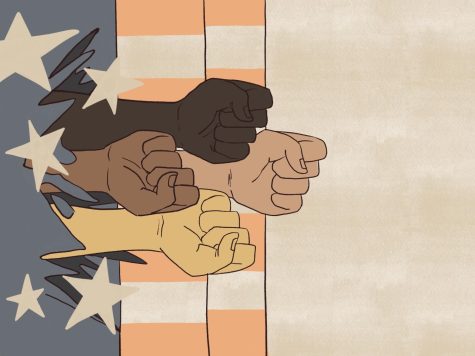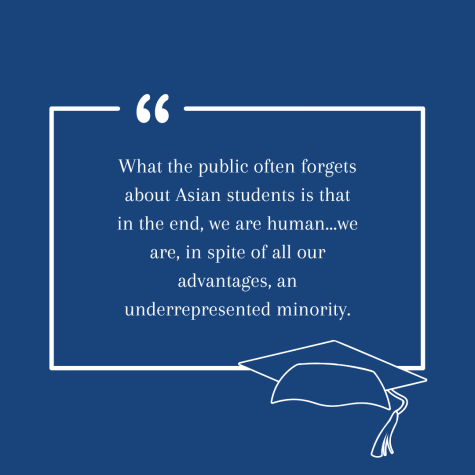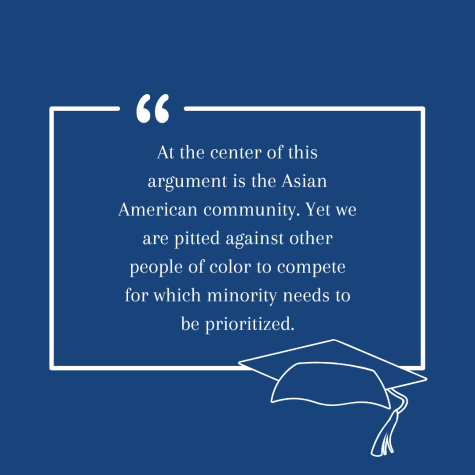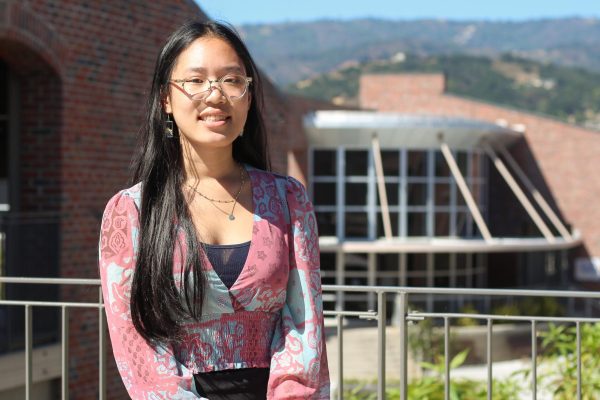White supremacy is pitting minorities against each other
Affirmative action discussions are plagued by a lack of representation
November 13, 2022

Let me just put out there that I approve of affirmative action. I think it is necessary, and I think it should not be torn down. Personal opinions aside, the issue of affirmative action gets tiring to hear about after a while.
Appreciate your privilege, is what proponents tell Asian Americans when it comes to affirmative action. You aren’t losing anything, you’ll just go to Cornell instead of Harvard, Caltech instead of MIT. And no one can deny that many of us do have privilege. RSM and Kumon are our drugs and alcohol, races for club officer positions serve as our adrenaline-inducing gang fights, and we do so all with the cushion of our parents’ tech jobs behind us.
On the other side, politicians champion that our merit gives us value. Asian American students work so hard so to be at the top of their classes, so they are the ones who deserve to get into top colleges. To them, we embody the model minority that makes affirmative action so unconstitutional.
And that is the misconception that plagues the Asian American experience with affirmative action. To generalize Asian Americans with these ideas is ridiculous; not everyone can or even wants to take cram classes, not everyone is competitive to hell and back and not everyone’s family is “rich” enough to support all types of higher education.  In fact, Asian Americans had the largest income inequality among all races in 2018 and since the start of the pandemic, Asian American hate crimes have plagued the community. What the public often forgets about Asian students is that in the end, we are human. Rich or poor, smart or dumb, we cannot be put in a single box of ideal stereotypes. After all, we are, in spite of all our advantages, an underrepresented minority.
In fact, Asian Americans had the largest income inequality among all races in 2018 and since the start of the pandemic, Asian American hate crimes have plagued the community. What the public often forgets about Asian students is that in the end, we are human. Rich or poor, smart or dumb, we cannot be put in a single box of ideal stereotypes. After all, we are, in spite of all our advantages, an underrepresented minority.
That’s not to say that Asian Americans aren’t privileged, especially in the Bay Area. But to reduce it to an argument of which minority is more or less privileged is useless and wrong. It feels as though affirmative action has become more about comparing who suffers the most, rather than considering the value of culture and diversity.
On Oct. 31, Supreme Court hearings about the Harvard and U.N.C affirmative action cases began. The group suing Harvard, the Students for Fair Admissions, is led by Edward Blum, who campaigned for Abigail Fisher’s case against affirmative action in 2013. Blum has long been fighting against affirmative action, and it’s no coincidence that all the photos used on the SFFA website are of Asian students now instead of the white students he initially fought for. To Blum, Asian Americans aren’t special. No one pushed him out there or encouraged him, nor does he have a strong connection to the Asian American community. Representing the Asian American minority is just the angle that is strongest for him now.
According to the New York Times, Patrick Strawbridge, a lawyer for Students for Fair Admissions, claimed that including personal essays on race was a different matter to affirmative action. “What we object to is a consideration of race and race by itself … [Personal essays tell] you something about the character and the experience of the applicant other than their skin color.”
Surely Strawbridge knows that there’s a wide variety of skin colors across Asia, right?
The lack of understanding of cultural nuances is evident even just through the language of people on either side of the argument. Race and culture play a huge part in our identities as Asian Americans, in the same way it does for other minorities. No one can deny that, especially in the Bay Area where we embrace our cultures so openly. Skin color and race can tell a story, in so many different ways. Someone who is a dark-skinned Asian is likely to have experienced colorism. Children of South Asian descent might have experienced war and poverty in a way that children of mainland Chinese descent have not. From food and traditions down to personal history, Asian culture is complex and long-spanning in impact, and the people seemingly representing that certainly are not familiar with such nuances.
Harvard’s lawyer, Seth P. Waxman, said that “race for some highly qualified applicants can be the determinative factor, just as being an oboe player in a year in which the Harvard-Radcliffe Orchestra needs an oboe player will be the tip.”
So what then? When students of color are picked solely to fulfill Harvard’s orchestra of diversity? What does that say about how much colleges truly care about the disadvantages minorities face? Again, this isn’t to discredit the need for affirmative action, but rather to point out, yet again, the lack of focus on the true issues that people of color face.
Affirmative action has its flaws and its benefits. At the center of this argument is the Asian American community. Yet we are pitted against other people of color to compete for which minority needs to be prioritized. Regardless of one’s opinion on affirmative action, Asian Americans have become the scapegoat used in pushing down other racial minorities. Barely any Asian Americans show up in the national discussion about affirmative action, especially in the current case going to court. How many prominent Asian American justices, lawyers, or plaintiffs in the Harvard affirmative action court case can people name? I assure you, I certainly had a hard time doing so.
In these recent hearings, Justice Clarence Thomas said, “I’ve heard the word ‘diversity’ quite a few times, and I don’t have a clue what it means.”
Diversity is what we do not have. What we have is a lack of visibility for Asian Americans in public office and in national problems that impact them. What we have are politicians and officials that still do not truly represent the demographics of the US. Diversity is what gets new perspectives out into the world where they are needed, where they can be represented and considered personally instead of by a proxy we never asked for.

















